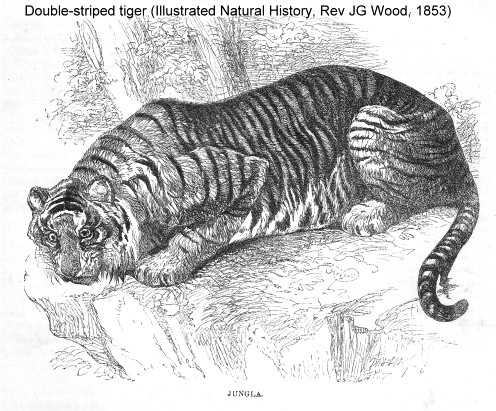
|
COLOUR & PATTERN VARIATIONS IN THE BIG CATS |
THE PERMANENT RACES OF THE LARGER SPECIES OF FELIDAE The Field, 25th March 1871

Sir, - The suggestion of your esteemed correspondent J.F. (in p. 209 antea) that I actually do not know an old tiger from a young one, may be very highly plausible beyond a doubt; only (somewhat unfortunately for his not particularly recondite hypothesis) it does happen that I am about as familiar as anyone well can be with the appearance of tigers of all ages and all stages of growth, from kittenhood to maturity and senectitude, having even possessed not a few living individuals of them in my time, small and large – cubs, adolescents, and adults. Not only, too, is this the case, but since the publication of my note discriminating the five races of tiger I have examined a considerable number of flat tiger-skins, and have had the good fortune to detect several more examples of the small many-striped race, which completely settles and decides the question, in my opinion, as to whether the only one that I had previously seen of this race was or was not a mere individual “sport” or variety of Felis tigris in the aggregate. Those skins may be seen and examined at the “Zoological Studios” of Mr James Ward, No. 27, Harley-street, and Harley-mews South. All of the many-striped tiger-skins hitherto examined by me are of the same comparatively small size, which is that of the large and beautifully-marked race of jaguar that inhabits the valley of La Plata, as distinguished from the Brazilian jaguar or that which inhabits the valleys of the Amazons and its vast tributaries. Your correspondent J. F. would do well to have a look at the specimens referred to (if he chances just now to be in town), and also to call upon Mr Barton, 120, Wardour-street, Oxford-street, in whose shop he would have the opportunity of comparing a skin of the very large race of tiger with comparatively few and mostly short stripes (which incline to be double, and the pairs of them meeting, or nearly meeting, more or less so, at each end, forming transverse elongated rhomboids to a considerable extent), with characteristic examples of the ordinary race of Indian tiger, which is of intermediate size, and likewise intermediate in its markings and in the total number of stripes. There is an unusually handsome skin (belonging to H.R.H. the Duke of Edinburgh) of what I shall now venture to denominate the grand or imperial tiger - as distinct from royal tiger - in the shop of Mr Henry Ward, of Vere-street, Oxford-street; and I have lately examined nine or ten other examples of this particular race of tiger. The brevity of the duplex stripes in these suggests a distant, though still manifest, approximation to the imperfect annuli of spots in so many of the pardine series of cats; and stripes (as a whole) are prevalently more elongated successively in the Indian royal tiger and in the Indian small or many-striped tiger. The skin of the beautiful leucoid or semi-albino tiger, now with Mr Edwin Ward, of Wigmore-street, is a fair average example (as regards its markings) of the Indian intermediate or royal tiger; for that very remarkable skin is not that of a perfect albino, as was the white tiger exhibited half a century ago in the then Exeter Change menagerie, as well as the others which I had heard of previously to seeing the specimen now with Mr Edwin Ward; but it has the ordinary stripes, which are somewhat pallid rufous-brown, instead of their being black as usual.
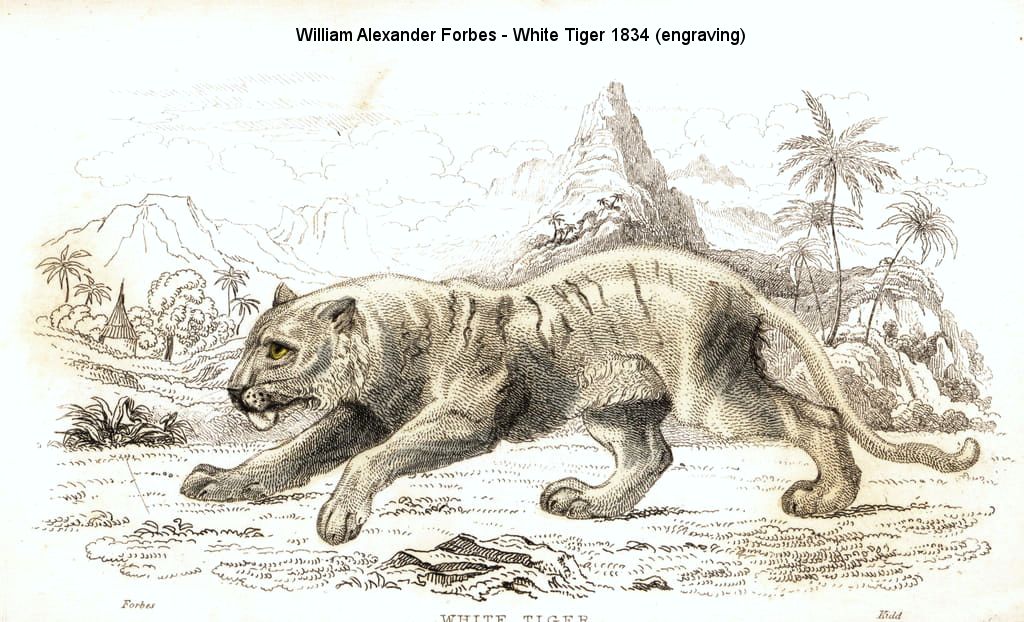
Be it remembered that a tiger can no more change its stripes than a leopard can change is spots; albeit a smart Yankee lad is alleged to have replied profanely to that familiar scriptural proposition, ‘that “surely the leopard can move from one spot to another!”
In the two large stuffed specimens of tigers which are exhibited in the British Museum, the one to the right of the spectator who fronts them is a small, perhaps not fully grown, example of the gigantic or imperial race, which attains a magnitude superior to that of any lion and which I take to be the “oontia bagh” of J. F. (signifying camel-tiger - a name applied to the lion in India wherever the lion is known, doubtless because the colouring of the lion is the usual colouring of the camel - i.e., the general coloration of desert animals, as wild asses, gazelles, &c.); while the other - as also the stuffed skin of a cub - exemplifies the ordinary intermediate, or Indian royal tiger, which I recognise as his “todhia bagh.” As the two large specimens in the British Museum are about of the same size, it is not the mere stature, therefore, which enables me to distinguish them apart. The larger kind has the appearance, when alive, of being longer in the body, and of standing higher on the limbs; but this appearance is deceptive, as it arises from there being much lees of loose skin pendent from the under parts in (the mature male at least of) the imperial tiger, than in the Indian royal tiger. In the Javanese tiger, which is of the same size as the Indian royal tiger - as is likewise the long-furred tiger of Northern Asia - the rufescence of the lower parts corresponds to what is seen in the Malayan so-called “wild dog” (Cuon sumatranus seu rutilans) [. . .]
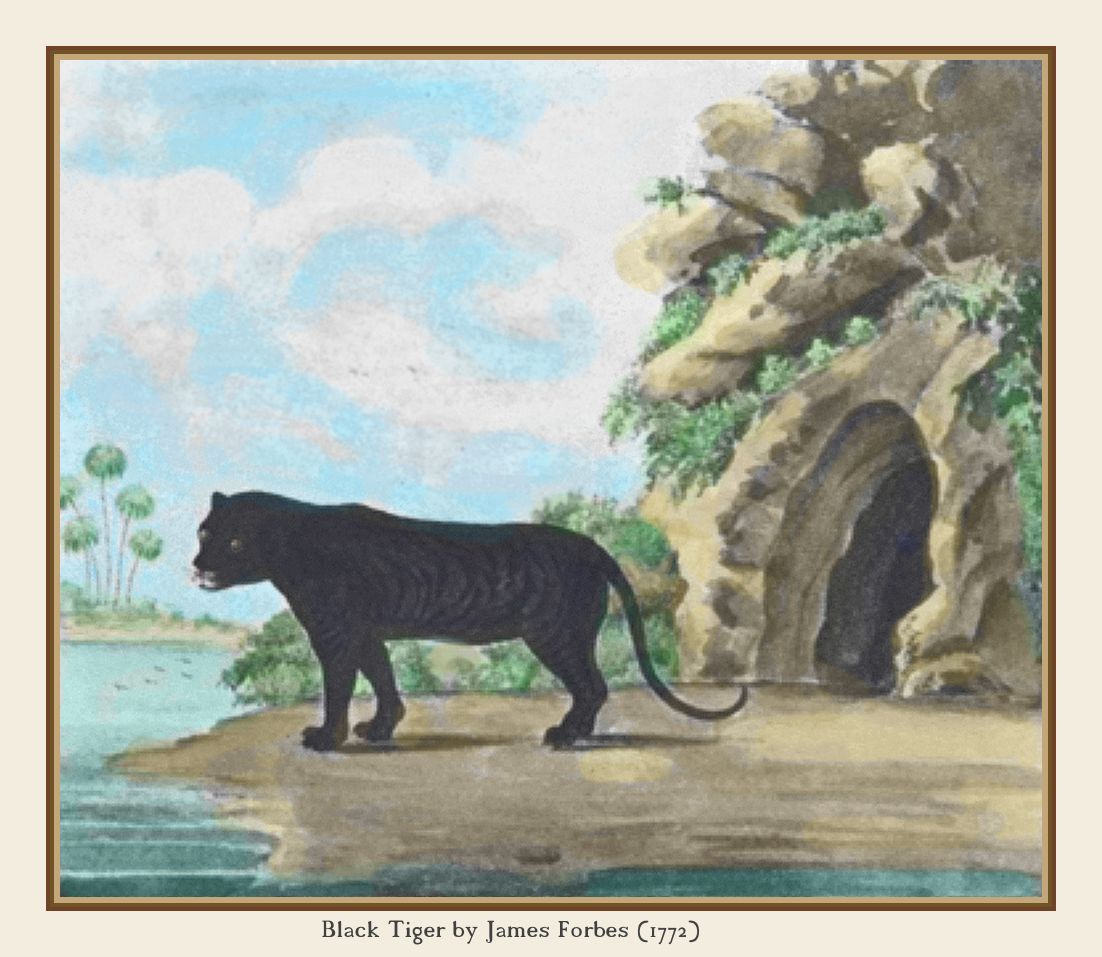
Tigers are the only felines known to me which, in the wild are subject to albinism. Of alleged black tigers I have never heard but of one that did not, upon investigation, prove to be either a black pard or jaguar, and that single exception occurred in the Javanese race, which particular race (with fulvescent under-parts) is probably not subject to albinism. Should a genuine black tiger ever occur in India, or elsewhere than in Java and Bali, I think I can venture to predicate that it will happen in the small many-striped race, which again may not be subject to albinism. I moreover suspect that all albino tigers appertain to the Indian intermediate or royal race (which is the same throughout India, Indo-Chine, the Malayan peninsula, and island of Sumatra), whereas I much suspect that the imperial race of tiger belongs chiefly to India northward of the Vindhyian Ghats, and the small many-striped tiger principally, or even wholly, to the table-land of the Dukhan. I have seen a black kitten pard before its eyes were open (bred in England in a travelling menagerie) which was one of a litter of four, the three other cubs of the same litter being of the ordinary colouring; but in this instance the sire was black, and the dam coloured as usual. Melanous and melanoid individuals of pards, and also of jaguars, are not very uncommon, though considerably less frequent – if indeed, they occur ever – in the paler-coloured races of pard which, as a prevalent rule, inhabit colder countries, whether by reason of latitude or elevation. Felines of the desert coloration, as F. leo, concolor, jubata, caracal, and in a less marked degree F. chaus, caffra, and their immediate kindred (the small desert species akin to the domestic cat, as distinguished from the corresponding woodland species, as the European F. sylvestris of Brisson and the Mongolian F. manual - the former having tapering, and the latter untapering tails as likewise seen in the forest lynxes as distinguished from the caracal or desert lynx), would seem to be subject neither to absolute leucotism nor to absolute melanism, nor likewise, I suspect, to absolute pyrrhonism; but they are occasionally melanoid or infuscated, sooty-looking, as happens in all of the species just enumerated, and I much suspect that all of them are subject to what may be termed leucoidism (pallid) and pyrrhoidism (rufescent) as well as to melanoidism (infuscated), A melanoid caracal is figured in one of Joseph Wolf's incomparable “sketches;” a family of melanoid lions (in Sindh) are noticed in one or more of the early volumes of the Bengal Sporting Magazine [. . .]
Professor H. Schlegel, who so ably directs that surpassingly rich zoological collection, orally convinced me that the Western African Felis aurata of his predecessor, the late Professor Temminck is a pyrrhoniam of F. celidogaster; and the kindred Indo-Chinese and Malayan species, F. Temminokii (which name was originally bestowed on a kitten of it, murmensis of Hodgson applying to the same species), is usually pyrrhous without body markings, sometimes melanoid without body markings, and sometimes more weakly pyrrhous with very distinct body markings of a deeper hue, the pattern of which is much the same as that of the markings upon an ordinary South American ocelot (F. pardalis). Both of last-mentioned phases of F. Temminckii are exemplified by mounted skins in the India House Museum, the zoological treasures of which have now been so very long quite inaccessible for purposes of reference; and there also is the original “type specimen” of the kitten of the same species, from Sumatra, though there happens to be another just like it (and probably one of the very same litter) in the British Museum. I have seen the mature animal from Malacca, and there is living example of it from Asam (if I mistake not) at present in the Zoological Gardens, Regent’s Park. In the so-called “clouded tiger” (F. macrocelis) the ground hue gradually changes from cat-grey to fulvous as the animal advances in age but in two much smaller species which are closely akin to it, F. Charltoni of the Eastern Himalaya (F. Ogilbii of Hodgson) and F. marmorata which is common in the vicinity of Malacca, all of the few skins which I have seen of the former had a fulvescent ground hue, and all of the many skins which I have seen of the latter had a non-fulvescent ground hue; wherefore analogy with F. macrocelis would suggest that they are merely the same animal at different ages, only that F. Charltoni is likewise of a size larger, and has proportionally larger paws. The beautiful F. macrocelis appears to be quite the same in the Indo-Chinese countries - inclusive of the protrusion of the zoological region to which they appertain along the flanks of the Eastern Himalaya - and in the islands of Sumatra and Borneo; but it is represented by a nearly akin and rather smaller species, F. Diardi, in Java. F. maocrocelis also doubtless inhabits the mountain spine of the Malayan peninsula, but I am unaware that it has as yet been observed there by any naturalist, and I have seen a fine skin of it which was procured in the mountains that separate Arakan from Pegu. In a very small Indian cat (F. rubiginosa), which I believe to be peculiar to the Coromandel coast and the low northern half of Ceylon [. . .] there are large ferruginous, alias pyrrhous, spots on the under parts, and the animal is likely to be wholly pyrrhous occasionally, like its representative in the Malayan peninsula, Sumatra (?), and Borneo (F. planiceps), which would appear be normally, if not always, pyrrhous. F. rubiginosa is decidely an uncommon species, so far as hitherto observed, and it would seem to be replaced, either in the Dukhan, or, may be, the Concan (or strip of low maritime territory extending along the foot of the Malabar Ghats), by the kindred and equally diminutive P. Jerdoni, which has the pardine markings of F. bengalensis. I do not believe that P. rubiginosa inhabits the Malayan peninsula, although a mounted skin of it in the British Museum is labelled from Malacca. That particular specimen was received along with Col. Charlton's fine collection of skins of mammalia, which he personally obtained at Malacca, and is therefore naturally supposed by Dr Gray to have been brought from the Malayan peninsula; but I happen to have looked very carefully over that same collection of skins when it was in Calcutta, and in company with its then owner, Col. Charlton, and I can confidently assert that F. rubiginosa was not among them at that time, for I could not well have overlooked It under the circumstances; and soon afterwards the Colonel took his departure for England, accompanied by his zoological collection, calling doubtless at Madras on his route home, where he might, likely enough, have picked up the skin of F. rubiginosa, which in all probability explains how it came to be mixed up and included in the otherwise exclusively Malayan collection of mammalia which he presented to the national museum. All of the non-volar species of the class which are common to the eastern and western sides of the Bay of Bengal inhabit likewise the intervening territory of Lower Bengal, which is at the head or apex of the bam and this is the case with the Indian Fishing cat F. viverrina, but most assuredly not with F. rubiginosa. All this by way of digression; but it is just as well to try to set matters to rights when an opportunity presents itself of so doing.
|
|
|
With regard to pumas, I consider that the very large pale silvery-brown race, with tail not longer than in the lion and jaguar, and having much loose pendent skin on its lower parts, which inhabits the valley of La Plata, is a thoroughly well distinguished species; as the large and beautifully-marked jaguar of the same territory – of equal size with the many-striped tiger of India – is also a peculiar race of jaguar, differing from that which inhabits the valley of the Amazons and those of its great tributaries. The puma of Paraguay is altogether much more leonine in its appearance than other pumas, recalling to mind a lioness, though the head is a good deal smaller in proportion to the size of the body than in F. leo. It is evidently also the emphatically desert from of puma, in which again it more immediately parallels the lion; whereas other pumas inhabit forest as well as open country, as do likewise the major-continental pards. All other pumas except this one have the tail as much lengthened as in the major-continent group of pards; and I conceive that the jaguars of South America represent in form and habits (both of them voluntarily entering the water), but not in colouring, the lion or lions of the major continent; whereas the long-tailed pumas represent in form and habits (neither of them ever voluntarily entering the water), but not in colouring, the pards of the major continent; the Paraguay puma showing remarkable analogies alike with the lion, the tiger, and the jaguar, and appertaining to a particular section, per se (in my humble opinion). Then I distinguish the ordinary pale silvery-brown long-tailed puma of North America(which is coloured like that of Paraguay), and which has passed southward along the flanks of the Andes into Patagonia - or much more probably the reverse - from the considerably smaller and much more deeply coloured, as also much more rufescent, long-tailed puma (F. unicolor?) which inhabits the valley of the Orinoco, if not likewise those of the Amazons and its immense tributary streams - i.e., the areas which are severally and respectively drained by those main rivers - and which race is represented by the pair of pumas which are at this time in the Regent’s Park collection; whereas the mounted skins of pumas in the British Museum exemplify that larger and much paler race which is common to North America and to Patagonia (F. concolor vera). The jaguarondis (of again two races, a larger and a smaller) are normally melanoid, but are (one or more) distinct small species of the true long-tailed puma group; and my late distinguished friend and frequent correspondent at one time, Col. C. Hamilton Smith, in the accuracy of whose judgment in such matters I repose an ever-increasing confidence (from very much corroborative observation on my part), has indicated two still additional races puma, both of which I expect will prove to be as good species as any to which that systematic rank is currently assigned. One of them is a black puma, symmetrically relieved with a little white, and therefore not an occasional melanism of any brown species - besides that I doubt of melanism occurring in any animal which possesses the desert coloration, such animals being at most only melanoid; and the other would seem to be a permanently spotted puma, which retains for life those markings which are peculiar to the young of all the rest of the group, and which are likewise seen in lion cubs, and are far from being indistinctly visible in almost every mature lioness. Those black and permanently spotted races of puma are noticed by Col. C. H. Smith in his volume on the class Mammalia (p. 179), forming part of the well-known “Naturalist’s Library.”
The readers of my first notice of the five distinguishable races of tiger must have been considerably perplexed to understand what I could possibly mean by the expression “olivine animals” (in p. 185); I wrote asinine animals. The “size of the Brazilian jaguar” (in p. 184) was an oversight on my part for Paraguay jaguar, to which I meant to compare the small many-striped tiger of Southern India.
MELANISM IN THE FELIDAE The Field, 30th May 1908
The best known example of melanism in the great cats is that of the Asiatic leopard, which, on account of fts peculiar coloration was given specific distinction (Felis melas) by Desmarest, though the occurrence of black and spotted cubs in the same litter has shown it to be no more than a variety. Examples of these black leopards, in which the markings give the skin an appearance like that of watered silk, have been exhibited in the Zoological Gardens, at many places on the Continent, and even in travelling menageries; and a black cub is recorded as having been born in the Amsterdam Gerdes. Their home appears to be Southern India and the Malay Peninsula. The transition from the normal coloration to that in which the ground colour becomes a sable only less deep than that of the markings seems to be abrupt in the Asiatic leopard - that is, there appears to be no records of skins in which the ground colour is of intermediate shades.
The first notice of incipient melanism in the African leopard is probably that by Mr Roland Trimen (P.Z.S., 1883, p.535) of an animal obtained in the east of Cape Colony in 1870. The most noteworthy character was the abundance of small black simple spots, almost to the exclusion of the ordinary ‘rose’ or ‘ring’ spots.” The specimen was in the Albany Museum, Grahamstown, and described in the catalogue as “a cross between the ordinary and black leopards.” Mr Trimen then expressed the opinion that the well-known black form of the leopard had never been met with in South Africa (if in Africa at all), and preferred to regard this specimen as “an interesting aberration in the direction of complete melanism of the so-called Felis melas.” Dr Gunther exhibited and described at a meeting of the Zoological Society a fiat skin obtained near Grahamstown, and now in the British Museum (P.Z.S. 1885, p. 245). This showed incipient melanism and Smit’s drawing of the animal was reproduced in the Field of April 25 by the courtesy of Dr P. Chalmers Mitchell. A photograph of another skin was exhibited by Dr Ginther in the following year. In this the black extended over the back and sides, the markings being confined to the limbs. With the skin Mr Nendick Abraham sent note, in which he said that “the spots do not even show through the skin as in the black leopard of Java.” (P.Z.S., 1886, p. 203.) Four specimens, all from same district, were known to him, and two living animals had been seen, but not captured. Mr W.L. Sclater (Fauna of South Africa, Mammals, i. 37), in referring to these specimens, remarked that this South African variety must be accounted as much a black “leopard” as any of those occurring in Southern Asia, and thus defined the differences between the two:
“In the Asiatic black leopard the melanism is caused by the darkening of the tawny ground colour, and the rosettes can be seen somewhat like spots on watered silk in certain lights, whereas in the African variety the melanism seems to be caused by the great increase in the spots, which finally fuse to form a uniform black livery.”
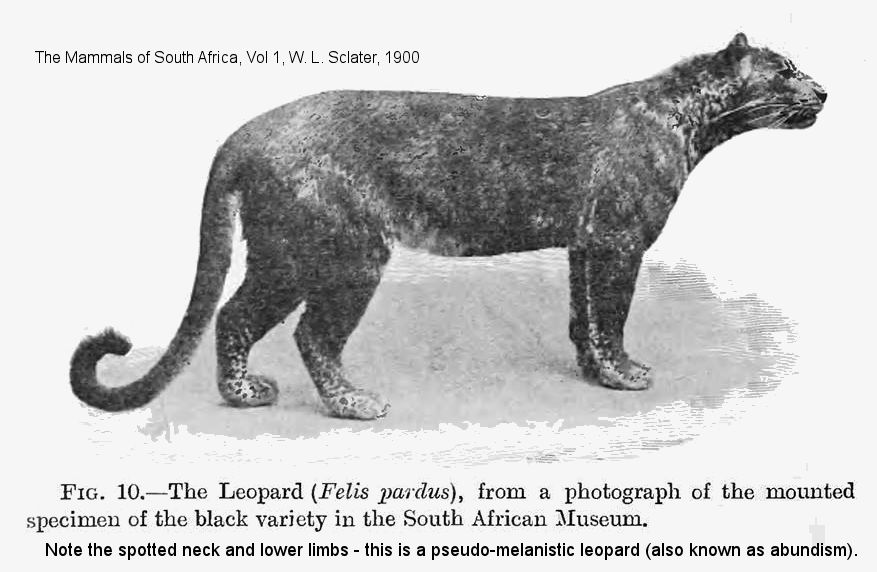
Of late a few skins exhibiting various degrees of melanism have been imported from Abyssinia, unfortunately without definite history, Beyond the fact they were obtained in that country. Some were recently presented to Mr Clarkson Williams while he was on a shooting expedition in Abyssinia. For him they were made up as rugs by Walter Burton, of Wardour-street, on whose behalf seven of them were exhibited by Mr henry Scherren at the scientific meeting of the Zoological Society on Tuesday April 28. A well-marked gradation was observable, from a deepening of the ground colour along and on each side of the dorsal line to deep tawny with very numerous small black spots, and in two the ground colour was black with a rufous tinge, the markings being a deeper black, and consequently distinctly visible in certain lights, so that with regard to these Mr Sclater's distinction does not hold good. It was stated by the exhibitor that similar skins had been intrusted to Mr Rowland Ward, of Piccadilly, who hoped before long to obtain some from European sportsmen, who would be able to give a definite history of them. Pocock referred to the extreme interest of the exhibition of skins from a part of Africa where the existence of nigrescent and black leopards had not previously been recorded. It is to be hoped that British sportsmen will now be on the look-out for trophies of this kind, and, with a British resident at Adis Abeba, it may be possible to secure Abyssinian black leopards for the gardens.
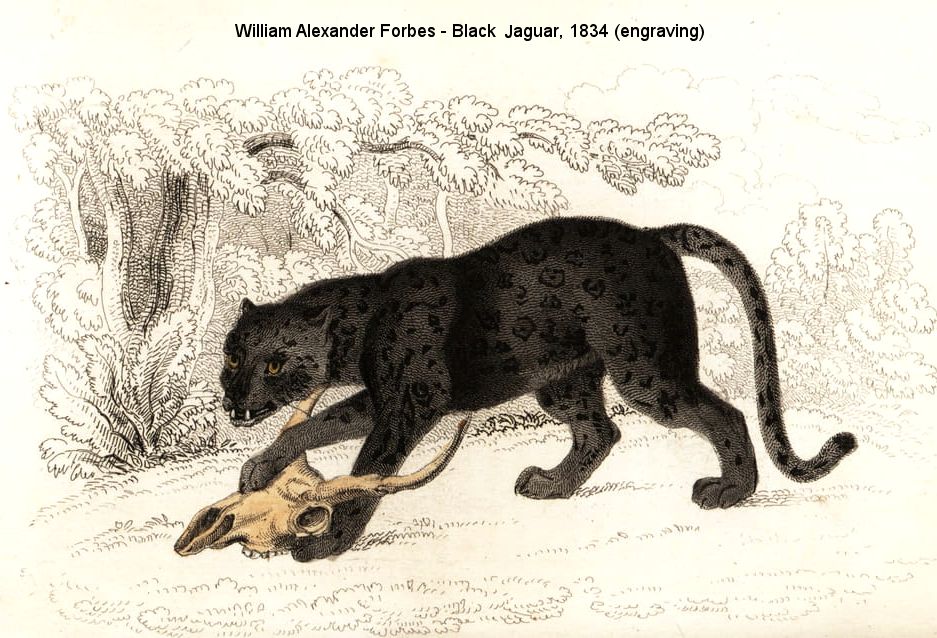
Melanism in the large cats seems to be practically confined to the leopards. Black Jaguars, however, are recorded. There is – or was till recently - one In the Berlin Garden described as entirely black (ein ganz schwarzes Mannling), though none appears to have been exhibited at Regent's Park. This variety, the Felts nigra of Erxleben, is not often brought to Europe. Nearly black pumas are recorded on the authority of Burmeister. A black tiger was found dead at Chitagong in March, 1846 - it was described in the Field (March 23, 1889) by Mr T. Buckland, who saw it, as a full-sized tiger “with black or very dark-brown skin, so that the stripes showed rather a darker black, just as the spots are visible on the skin of a black leopard.” It had been killed by a poisoned arrow, and wandered away to die. In the Royal Natural History (i. 413) Mr Lydekker observed that the black serval must be comparatively common near Kilimanjaro, since the natives had a distinct name for it; and said that in a black skin from South Africa in the British Museum the spots were distinctly visible in certain lights; and one killed by the Master of Belhaven about twenty miles from Mount Kenia was recorded in the Field of Dec. 28, 1907 (p. 1118).
MELANISM IN THE FELIDAE The Field, 6th June 1908
Sir, -Will you allow me to correct one or two small inaccuracies In your Interesting account of melanism in the Felidae in the Field of last week. I am reported as having referred to the skins of the black leopards from: Abyssinia exhibited by Mr Scherren before the Zoological Society on April 28 as extremely interesting on account of the previous absence of records of black leopards from that part of Africa. As a matter of fact, after commenting upon certain interesting features connected with the exhibition, I added that Major Leveson, better known as “the old Shekarry,” mentions shooting a black panther in the passes above Ailet on Sir Robert Napier’s expedition in 1868 against King Theodore of Abyssinia (Sport in Many Lands, p. 491). It is not surprising that this reference has been overlooked hitherto. Major Leveson’s silence as regards any peculiarity in the melanism of this black leopard justified the inference that the animal resembled in this particular Indian black leopards with which he was familiar. The correctness of this inference was confirmed by the two black skins exhibited by Mr Scherren. I cannot, however, quite agree with Mr. Scherren that the other skins he exhibited at the same time showed any gradation towards melanism. They appeared to me to be merely lighter and darker tinted normally coloured specimens, with the under side of the body and the inner side of the limbs clean white. True black leopards have these areas rufous or rusty black, at all events as a rule. In this particular they differ markedly from the so-called incipiently melanotic Grahamstown leopards recorded in the Proceedings of the Zoological Society. But I do not think it has been previously remarked that the specimen of this variety mounted in the Cape Town Museum, and figured by Mr W. L. Sclater, differ from the rest, if the figure is to be trusted, in having the underside dark, like the remainder of the body. It appears, therefore, that in these Grahamstown leopards there is a complete gradation from the specimen with the black present only on the back. as shown in the figure in the Field, though the typical example of Felis pardus melanotica, in which the black extends down the sides, to the Cape Town museum specimen, in which it involves the belly also. It has been stated that the blackness of these leopards arises solely from the coalescence of the disintegrated spots. This is not the case. The narrow intermediate areas also become heavily pigmented.
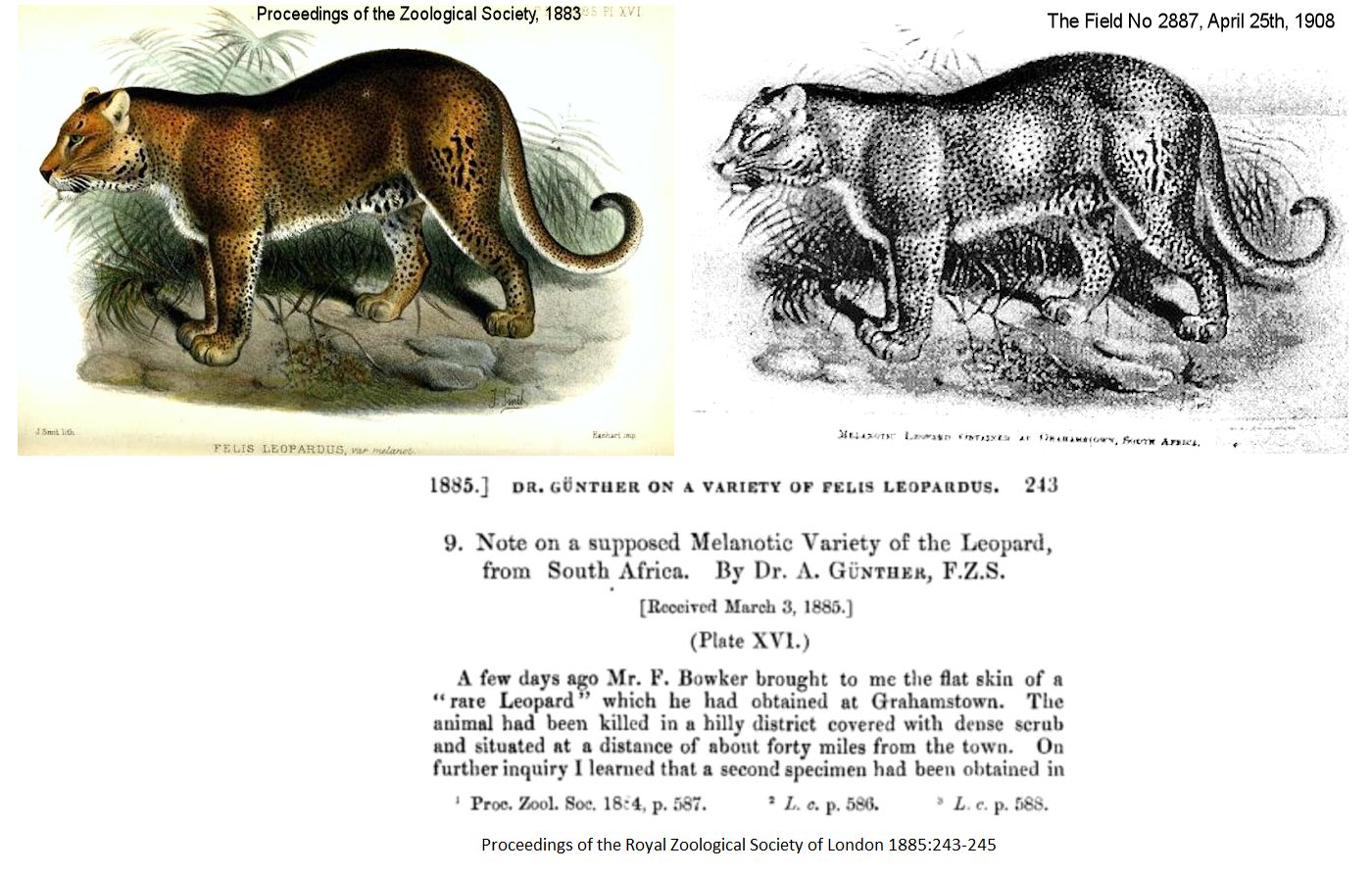
Pseudo-melanistic leopard, once posited as a leopard x cheetah hybrid |
Another point of interest arises from this question of melanism. In many, perhaps most, black leopards and jaguars, the areas that are nominally white assume a reddish-black hue and are comparable to the tan areas of black and tan dogs. I have shown that these areas represent white or pale areas in wolves, while the black areas in the dogs correspond to the pigmented parts of the body in wolves. This seems to be a common law of colour change in nigrescent animals. Conversely in the case of albinescent individuals, when reddish or tan areas become white, black areas commonly become red or tan. For example, in the skins of an albino tiger and of a cheetah in the Natural History Museum, the ground colour is white, and the stripes in the one case and the spots in the other are pale tan.
R. I. Pocock, Zoological Society’s Gardens.
|
BACK TO HYBRID & MUTANT BIG CATS INDEX |